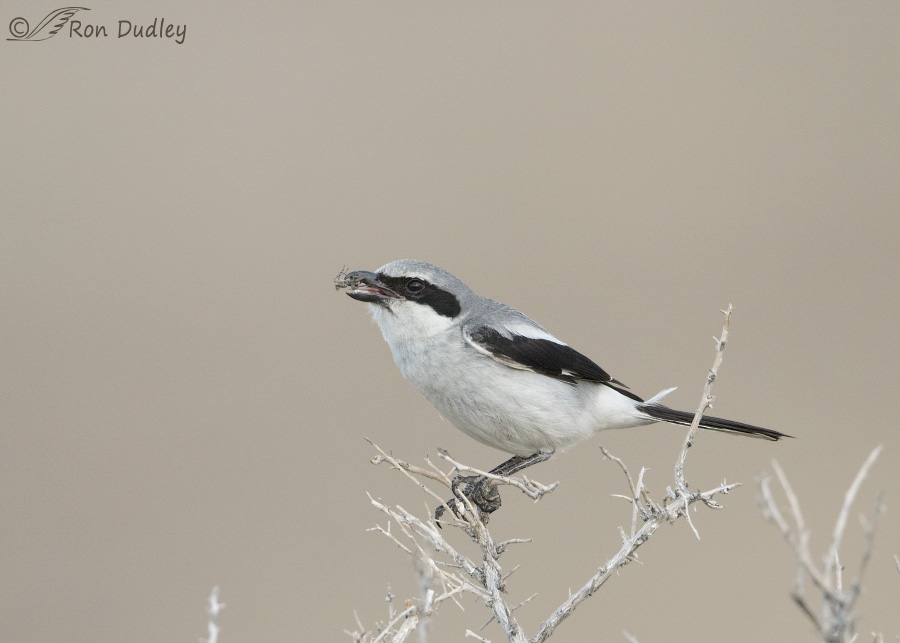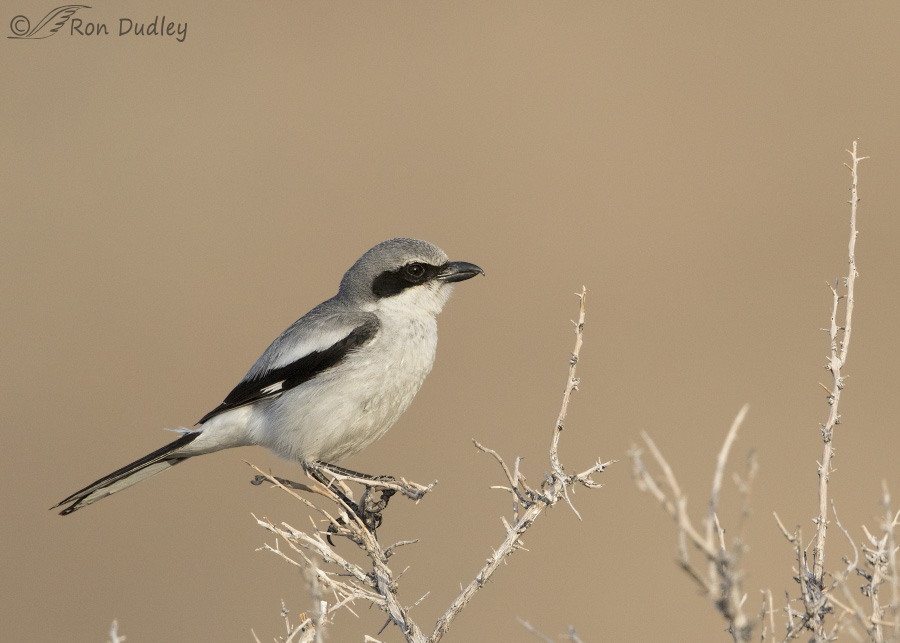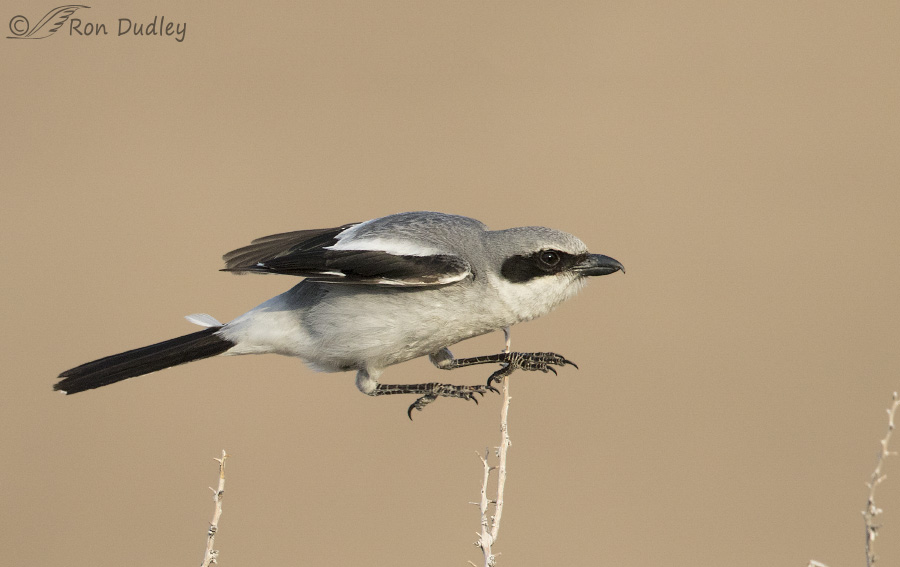With birds it’s quite often the little things that grab my attention and they don’t come much smaller than this. It was subtle and quick, very quick, but it’s one of the strategies that can make the difference between a meal and going hungry.
1/1600, f/5.6, ISO 1250, Canon 7D Mark II, Canon EF 500mm f/4L IS II USM + EF 1.4 III Extender, not baited, set up or called in
Yesterday morning on Antelope Island I caught this Loggerhead Shrike swallowing a spider (the island is absolutely loaded with spiders – the state park actually holds an annual Spider Festival). The shrike hunted from this perch for about 5 minutes – launching after potential prey and then returning to the same hunting platform.
When this shot was taken the sun was behind a cloud so I decided to crank up my ISO to get a little more shutter speed for takeoff shots. Even at ISO 1250 I needed more SS than this to get the wings of the incredibly fast bird sharp at takeoff but I was already at a higher ISO than I almost ever go.
1/3200, f/5.6, ISO 1250, Canon 7D Mark II, Canon EF 500mm f/4L IS II USM + EF 1.4 III Extender, not baited, set up or called in
Thankfully the sun came out four minutes later and doubled my shutter speed.
An instant after this photo was taken the shrike spotted prey (probably an insect or another spider) directly in front of it. In a typical takeoff the shrike would avoid any obstacles by altering its direction of launch. But in this instance the vertical twig to the far right of the frame was apparently almost exactly between the bird and its potential prey. To fly around it would take time and prevent quick acceleration so it wanted to go as close to the twig as it possibly could. Hitting it would of course slow the shrike down.
So it had a subtle way of dealing with the twig in flight if it needed to.
1/3200, f/5.6, ISO 1250, Canon 7D Mark II, Canon EF 500mm f/4L IS II USM + EF 1.4 III Extender, canvas added for composition, not baited, set up or called in
Normally most birds tuck their legs and feet under the base of their tail immediately after takeoff for aerodynamic reasons. But this shrike brought its feet far forward in case it needed to use them to push the twig out of the way in flight. It appears to me that it didn’t actually do it (the next photo that I haven’t included here suggests the same thing) but the shrike was prepared in case it needed to. To my eye it looks pretty strange to see the feet of the bird in this position soon after a takeoff or in flight generally. It almost looks like the bird might have been hop-flying to another nearby perch but it wasn’t. The shrike actually flew far off after this launch, I just happened to catch it with its wings mostly folded.
Several times I’ve photographed much larger birds (raptors in particular as they take off out of trees) using their feet to push twiggy obstructions out of the way but this is the first time I’ve documented something similar in a speedy little songbird.
See, I told you it was just a “little thing”… but IMO all the little things add up to a better understanding of birds.
And speaking of Loggerhead Shrikes – yesterday loyal blog follower Muffy S. Gately posted a link on Facebook to an absolutely fascinating video from Audubon (you don’t need to be a FB user to see it). Lasting 22 minutes it’s more a mini-documentary than it is a video clip but I highly recommend it if you have any interest in bird behaviors in general and/or Loggerhead Shrikes specifically. At least one of the behaviors has never before been documented (damn, I’d LOVE to have been the one to do that!) and if you’ve ever wondered why shrikes are often called “butcher birds” and “wannabe raptors” you’ll most definitely see why (and no, I don’t think the clip is gory at all).
Here’s the link if you have the interest. You need to scroll down a little to see it – the first clip is just a teaser. IMO it’s absolutely worth the time investment.
Thank you, Muffy.
Ron





Thanks for the link.
I hope to absorb it later. Dental ugliness is taking my focus this morning after breaking a tooth last night.
I am endlessly fascinated by behaviour. From our species as well. It isn’t always pretty but IS educational.
Ouch, so very sorry about the tooth, EC. I wish you a successful and painless dental visit!
Thanks so much to Muffy and to you for the video link—that’s one of the best educational videos I’ve ever seen/heard !
I agree, Kris. I thought it was top drawer…
For me, this was one of the most fascinating blogs you’ve ever posted…Between your images, your comments, the comments of others and the links , it’s so full of interesting information I will want to look at it many times….WOW!!!
That’s wonderful to hear! Thank you, Patty.
I really like shrikes now…and it’s all your fault!!!!
I’ll accept that blame, Patty – enthusiastically!
Great shots Ron, and the video was exceptional, many thanks for sharing.
It is sad that some of our agricultural practices aren’t aware of the benefits of wildlife.
All one has to do is read your blog and your ethics to see how wildlife photography should be conducted!!
Many thanks!!!!!
Thanks very much for the kind words, Dick.
Ron, is there a reason why the Government of Utah seemingly (or am I missing something) didn’t do anything about the toxic mercury poisoning? This is so sad!!
Part of the reason is because the precise sources of the mercury are somewhat of a mystery.
http://www.nytimes.com/2008/08/10/science/earth/10saltlake.html?mcubz=0
The other part of the equation is money and politics. Big business rules and politics protects the industries dumping contaminants into the remote west side of the lake from any meaningful regulation.
I think it’s interesting to see odd little behaviors like this. It’s one that makes perfect sense, even if unexpected. Hopefully I’ll get the chance to watch the video. One of our park rangers reported seeing a critter – I think it was a small bat – impaled on prickly pear spines, which is how I knew we had Loggerhead Shrikes. They are very interesting birds.
Susan, I’ve seen shrikes working on pulling meat from impaled voles but I’ve never seen them prey on snakes like those in the video did. Lots of fascinating stuff in that video.
Thanks for the link. It was very educational and I will certainly look at the Island’s shrikes more intensely from now on. A few years back I saw 2 young girls driving around the Island and stopping periodically to wander over to sagebrush plants and spend some time at each. Since I was patrolling, I was curious about what they were doing. Turns out they were part of a shrike study and had identified about 19 nests on the Island. They had small cameras videoing some of the nests, calipers to measure the young wing bones, and scales to measure the weight. Seems that there was not a lot of data on shrike nesting and rearing and they also hoped to learn more about where the majority migrated to in Winter. I think they were from USU but I never saw any followup info from the study but sure the Island’s biologist was involved. Would be interesting to find out what they discovered. They were very professional and careful handling the chicks and I did document some of their sites and techniques. Unique and fascinating birds!
Larry, They were from the Great Salt Lake Institute out of Westminster College. For several years GSLI worked on a study of how mercury contaminants in the Great Salt Lake were working through the food chain. Shrikes on the island are top predators at the end of that chain so they banded many spider-eating birds on the island, mostly shrikes, as part of their study. I donated several of my photos of shrikes eating spiders to GSLI.
Here’s a blog post I published about banded shrikes, GSLI and their study.
https://www.featheredphotography.com/blog/2012/02/09/birds-spiders-brine-flies-and-mercury-contamination-on-antelope-island/
Cool shot and VERY interesting video………. The one thing that struck me was the wing fluttering of the female on the nest when the male brought her food – I would have thought it was a young bird begging!
Yes, the behavior of the female and that of begging chicks is quite similar. Young shrikes are extremely demanding for food (and noisy) for weeks after fledging – they mob the adults whenever they come near. If I was a shrike parent they would certainly try my patience!
Fascinating video! Thank you, Muffy and Ron! Interesting to note that one of the “You might be interested in…” links at the bottom of the Audubon page was about ethical photography.
Ron, your takeoff shot makes me think of a longjumper in T&F.
You’re absolutely right about that track and field comparison, Marty. Back in the day I threw the javelin in high school and college and I watched many a longjumper while I was waiting to compete in my event.
And thanks for pointing out that ethical photography link.
I threw shot and disc in HS. No javelins for us then, lest someone try to be a javelin catcher. I wasn’t even close to being good enough to throw in college, so I stuck with the training room. “I love the smell of tape and TufSkin in the morning.”
I never saw any javelin accidents but I did see a couple of very close calls. Makes me shudder to think of what could have happened…